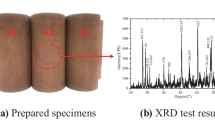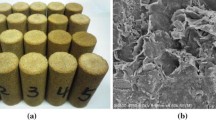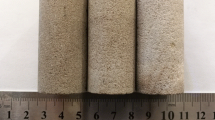Abstract
Poromechanical properties of a sandstone from an underground gas storage site are investigated with the use of a neutral gas to control the pore pressure. The poroelastic theory of anisotropic medium is used to evaluate elastic properties and coupling coefficients under different stress states. In-situ CT observations have been made under uniaxial compression test and they are used to underline some effects due to the occurrence of damage and microcraks. Under hydrostatic loading, pores and micro-cracks are gradually compressed. The initial state of the sandstone is “slightly” transversely isotropic but in a first approach the Biot’s tensor reduces to a scalar. This coefficient decreases with the increase in confining pressure that can be attributed to the closure of micro-cracks. The effect of damage and cracking is investigated with two series of conventional triaxial tests conducted at different confining pressures, either with an increase in pore pressure (series 1) or with a decrease in pore pressure (series 2), to evaluate the coupling coefficients. The results, derived from these two test series, are consistent as regards the effects of cracking on the material behavior. There is an obvious damage due to the triaxial loading which induces a parallel decrease in the ratio E3/(1 − ν3) and in the modulus H3. Axial compaction results in the continual increase in the H1 modulus observed for every sample whatever the measurement technique was.





















Similar content being viewed by others
Abbreviations
- ε 1 :
-
Axial strain
- ε 3 :
-
Lateral strain
- ε a c :
-
Axial strain caused by confining pressure
- ε a p :
-
Axial strain caused by gas pressure
- ε l c :
-
Lateral strain caused by confining pressure
- ε l p :
-
Lateral strain caused by gas pressure
- ε v :
-
Volumetric strain
- P c :
-
Confining pressure
- P i :
-
Gas pressure
- K b :
-
Skeleton bulk modulus
- K s :
-
Solid matrix bulk modulus
- H :
-
Coupling coefficient under hydrostatic stress
- H 1 :
-
Coupling coefficient in axial direction
- H 3 :
-
Coupling coefficient in lateral direction
- b :
-
Biot’s coefficient
- b 1 :
-
Biot’s coefficient in axial direction
- b 3 :
-
Biot’s coefficient in lateral direction
- E 1 :
-
Young’s modulus in axial direction
- E 3 :
-
Young’s modulus in lateral direction
- ν 1 :
-
Poisson’s ratio for horizontal strain due to vertical strain
- ν 3 :
-
Poisson’s ratio in the isotropic plane
- γ :
-
Deviatoric shear strain
References
Aichi M, Tokunaga T (2011) Thermodynamically consistent anisotropic constitutive relations for a poroelastic material saturated by two immiscible fluids. Int J Rock Mech Min 48:580–584
Alshibli KA, Alramahi BA (2006) Microscopic evaluation of strain distribution in granular materials during shear. J Geotech Geoenviron 132:80–91
Al-Tahini AM, Abousleiman YN (2010) Pore-pressure-coefficient anisotropy measurements for intrinsic and induced anisotropy in sandstone. SPE Reserv Eval Eng 13:256–274
Aoki T, Tan C, Bamford W (1993) Effects of deformation and strength anisotropy on borehole failures in saturated shales. Int J Rock Mech Min 30:1031–1034
Arfaee MIR, Sola BS (2014) Investigating the effect of fracture–matrix interaction in underground gas storage process at condensate naturally fractured reservoirs. J Nat Gas Sci Eng 19:161–174
Azin R, Malakooti R, Helalizadeh A, Zirrahi M (2014) Investigation of underground sour gas storage in a depleted gas reservoir. Oil Gas Sci Technol 69:1227–1236
Baud P, Meredith P, Townend E (2012) Permeability evolution during triaxial compaction of an anisotropic porous sandstone. J Geophys Res Solid Earth 117:B05203
Biot MA (1941) General theory of three-dimensional consolidation. J Appl Phys 12:155–164
Carroll M (1979) An effective stress law for anisotropic elastic deformation. J Geophys Res Solid Earth 84:7510–7512
Chen X-T, Davy CA, Skoczylas F, Shao J-F (2009) Effect of heat-treatment and hydrostatic loading upon the poro-elastic properties of a mortar. Cem Concr Res 39:195–205
Cheng A-D (1997) Material coefficients of anisotropic poroelasticity. Int J Rock Mech Min 34:199–205
Coussy O (2004) Poromechanics. Wiley, Oxford
De Jong C (2015) Gas storage valuation and optimization. J Natl Gas Sci Eng 24:365–378
Duan Z, Davy CA, Agostini F, Jeannin L, Troadec D, Skoczylas F (2014) Gas recovery potential of sandstones from tight gas reservoirs. Int J Rock Mech Min 65:75–85
Hu D, Zhou H, Zhang F, Shao J-F (2010) Evolution of poroelastic properties and permeability in damaged sandstone. Int J Rock Mech Min 47:962–973
Li Z (2016) Influence of the microstructure on mechanical properties and damage mechanisms in Al-Si-Cu alloys by using 2D and 3D in-situ analysis. Ph.D thesis, Lille 1
Lings M, Pennington D, Nash D (2000) Anisotropic stiffness parameters and their measurement in a stiff natural clay. Geotechnique 50:109–125
Lion M, Skoczylas F, Ledésert B (2004) Determination of the main hydraulic and poro-elastic properties of a limestone from Bourgogne, France. Int J Rock Mech Min 41:915–925
Liu Z, Shao J (2017) Strength behavior, creep failure and permeability change of a tight marble under triaxial compression. Rock Mech Rock Eng 50:529–541
Liu Z, Xie S, Shao J-F, Conil N (2015) Effects of deviatoric stress and structural anisotropy on compressive creep behavior of a clayey rock. Appl Clay Sci 114:491–496
Lockner DA, Beeler NM (2003) Stress-induced anisotropic poroelasticity response in sandstone. In: Electronic proceedings of the 16th ASCE engineering mechanics conference pp 1–13
Pei Y, Agostini F, Skoczylas F (2017) The effects of high temperature heating on the gas permeability and porosity of a cementitious material. Cem Concr Res 95:141–151
Shao J (1998) Poroelastic behaviour of brittle rock materials with anisotropic damage. Mech Mater 30:41–53
Song Y, Davy CA, Bertier P, Skoczylas F, Talandier J (2017) On the porosity of COx claystone by gas injection. Microporous Mesoporous Mater 239:272–286
Suarez-Rivera R, Fjær E (2013) Evaluating the poroelastic effect on anisotropic, organic-rich, mudstone systems. Rock Mech Rock Eng 46:569–580
Tan X, Konietzky H (2014) Numerical study of variation in Biot’s coefficient with respect to microstructure of rocks. Tectonophysics 610:159–171
Tan X, Konietzky H, Frühwirt T (2015) Experimental and numerical study on evolution of Biot’s coefficient during failure process for brittle rocks. Rock Mech Rock Eng 48:1289–1296
Wang H (2000) Theory of linear poroelasticity with applications to geomechanics and hydrogeology. Princeton University Press, Princeton
Wang Y, Agostini F, Skoczylas F, Jeannin L, Portier É (2017) Experimental study of the gas permeability and bulk modulus of tight sandstone and changes in its pore structure. Int J Rock Mech Min 91:203–209
Yuan H, Agostini F, Duan Z, Skoczylas F, Talandier J (2017) Measurement of Biot’s coefficient for COx argillite using gas pressure technique. Int J Rock Mech Min 92:72–80
Acknowledgements
The financial support by the China Scholarship Council (201406220155) for the first author is acknowledged. We are appreciated for the help of Gregory Hauss in test and analysis of in-situ compression CT.
Author information
Authors and Affiliations
Corresponding author
Additional information
Publisher’s Note
Springer Nature remains neutral with regard to jurisdictional claims in published maps and institutional affiliations.
Rights and permissions
About this article
Cite this article
Hu, C., Agostini, F., Skoczylas, F. et al. Poromechanical Properties of a Sandstone Under Different Stress States. Rock Mech Rock Eng 51, 3699–3717 (2018). https://doi.org/10.1007/s00603-018-1550-x
Received:
Accepted:
Published:
Issue Date:
DOI: https://doi.org/10.1007/s00603-018-1550-x




